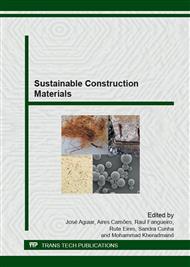[1]
B.S. Garzón: De la construcción tradicional a la racionalización de componentes en caña y tierra-cemento. In: Seminário Ibero-Americano de Construção com Terra. Anais. Salvador, Ba, Proterra/Cyted (2002).
Google Scholar
[2]
G. Minke : Earth Construction Hanbook. Wit Press, Southampton, England (2005).
Google Scholar
[3]
N.P. Barbosa; S.M. Souza and; R Mattone: Um método construtivo de casas populares com tijolos prensados de terra crua estabilizados com cimento. Quarto Congresso Brasileiro do Cimento, Associação Brasileira de Cimento Portland. Anais. São Paulo, nov 1996, vol 3, pp.263-276 (1996).
DOI: 10.17648/cbcm-2021-138650
Google Scholar
[4]
H. Houben; H Guillaud: Traité de construction en terre. Edition Parenthèses, Marseille, França:, (1989).
Google Scholar
[5]
S. M. T. Souza: Tijolos de terra crua reforçada com fibras vegetais. Campina Grande: UFPB. Dissertação de Mestrado em Engenharia Civil, Universidade Federal da Paraíba, Campina Grande, PB, (1993).
DOI: 10.14393/19834071.2013.24194
Google Scholar
[6]
K Ghavami; R.D. Toledo Filho; N.P. Barbosa. Behavior of composite soil reinforced with natural fibers. Cement and Concrete Composites, v. 21, (1999).
DOI: 10.1016/s0958-9465(98)00033-x
Google Scholar
[7]
M.A. Buson: Krafterra: desenvolvimento e análise preliminar do desempenho técnico de componentes de terra com incorporação de fibras de papel Kraft provenientes da reciclagem de sacos de cimento para vedação vertical. Tese de Doutorado. Faculdade de Arquitetura e Urbanismo Universidade de Brasília (2009).
DOI: 10.11606/9788580891225
Google Scholar
[8]
A. A. R. CORRÊA: Incorporação de partículas lignocelusósicas e baba de cupim sintética, no adobe. Tese de Doutorado. Universidade Federal de Lavras, MG (2013).
Google Scholar
[9]
J. Davidovits: Mineral polymers and methods of making them. US Patent 4. 349. 386 (1982). 14 (1982).
Google Scholar
[10]
L.S. de Oliveira; N.P. Barbosa; C.M. de Carvalho; F S. Santos: Stabilization of raw earth through alkaline activation. NOCMAT 2013, Anais. Trans Tech Publications, Switzerland (2014).
DOI: 10.4028/www.scientific.net/kem.600.215
Google Scholar
[11]
Earth Charter. Available on www. earthcharterinaction. org.
Google Scholar


